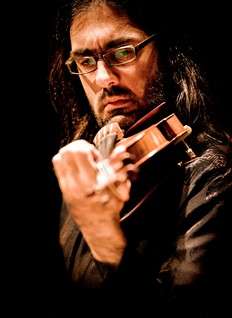|
Back
A Pianist Returns To His Violin Roots New York
David Geffen Hall, Lincoln Center
05/20/2017 -
Franz Schubert: Piano Quintet in A major (“Trout”), D. 667 (#)
Johannes Brahms: Violin Concerto in D major, Op. 77
Leonidas Kavakos, Sheryl Staples (#) (violin), Cynthia Phelps (viola), Carter Brey (cello), Timothy Cobb (bass), Shai Wosner (piano)
New York Philharmonic, Alan Gilbert (Conductor)

L. Kavakos (© Marco Borggreve)
“There is a passage in the Brahms Concerto in tenths, almost the widest interval demanded of a violinist. Rapidly and more or less in tune, I played these bars to prove to Busch that my hand was big enough for Brahms...”
Yehudi Menuhin, Unfinished Journey
What would a New Yorker most like to do on a sunny Saturday afternoon in May? Go to Central Park, the zoo, the Gateway nature reserve on the water, window shopping? No, the sophisticated urbane individual would want to hear the Brahms Violin Concerto at Lincoln Center.
Ede Reményi was a Hungarian violinist who befriended the 15 year old piano prodigy Johannes Brahms and soon thereafter took him on tour as his accompanist. Brahms later wrote three passionate violin sonatas – as well as a movement of the F-A-E Sonata – and the incredibly beautiful Violin Concerto. The New York Philharmonic, in one of its delightful Saturday afternoon concerts, presented this great opus preceded by a seminal work of chamber music. These events are always entertaining and ear-opening. I am amazed that other ensembles do not follow suit.
One of my most treasured memories is hearing many years ago a group of quite young aspiring musicians performing the “Trout” at summer music camp. In a superb performance, the pianist, who had just performed flawlessly the extended arpeggiated keyboard part in the middle of the fourth movement and would have only one beat to recover before diving back into the fray, let out a tremendous and quite audible sigh. I never think of this heavenly work without remembering that charming moment.
There are two ways to present the immortal quintet. To my taste, this ensemble chose the lesser one, emphasizing the airiness of the piece and the fragility of its poetry. Perfectly legitimate, however I would have preferred a more profound reading, following the outrage of the text:
“There thrashed the fish,
And I, with raging blood,
Gazed on the betrayed one.”
(translated by Betsy Schwarm)
But, to each his own. The group, led by Principal Associate Concertmaster Sheryl Staples, luxuriated in a whisper, presenting a love letter to nature and the bucolic ideal. It is difficult to argue this interpretation when it is presented this well.
Judging the zeitgeist of this approach on its own terms, the resulting performance was remarkable for its delicate power, like a flower (or a fish!). The string blending was gorgeous, the accuracy pinpoint for the most part, although guest pianist Wosner got a bit tangled during his version of the aforementioned arpeggiated part. All was running smoothly until the last movement which, although quite well-executed, ended much too soon in a torrent of audience applause, even though there was considerably more to come. The players had no recourse but to wait and then finish the piece with a palpably less ardent ovation at its actual end. Ah, those matinee concerts!
The Brahms was simply stunning. Leonidas Kavakos showed once again what a consummate artist he has become. Not at all hesitant about employing a wide vibrato, he launched into a profound reading, heavy on dynamic changes and subtleties of meaning. His frequent pauses in the first movement cadenza were thrilling and decidedly “old-fashioned” (read “like the masters used to play”).
The orchestra supported Mr. Kavakos expertly with a full-throated sound not heard from this ensemble in 10 years, in 20 years, in 30 years, in 40 years. All credit goes to maestro Gilbert for finally whipping them into shape. Liang Wang performed the oboe solo at the beginning of the second movement as if he were born performing it and the entire movement had the feel of a barcarolle or a reverie. After virtually no pause between movements, the Wordsworthian finale was positively dreamlike. Overall, a stunning effort and a much appreciated one.
Thus ends our third of five in a series presenting quintets. We will take a brief pause now to hear an opera ensemble in an orchestral concert followed by a symphonic ensemble mounting an entire opera. Then the quintets will resume, I assure you.
Fred Kirshnit
|